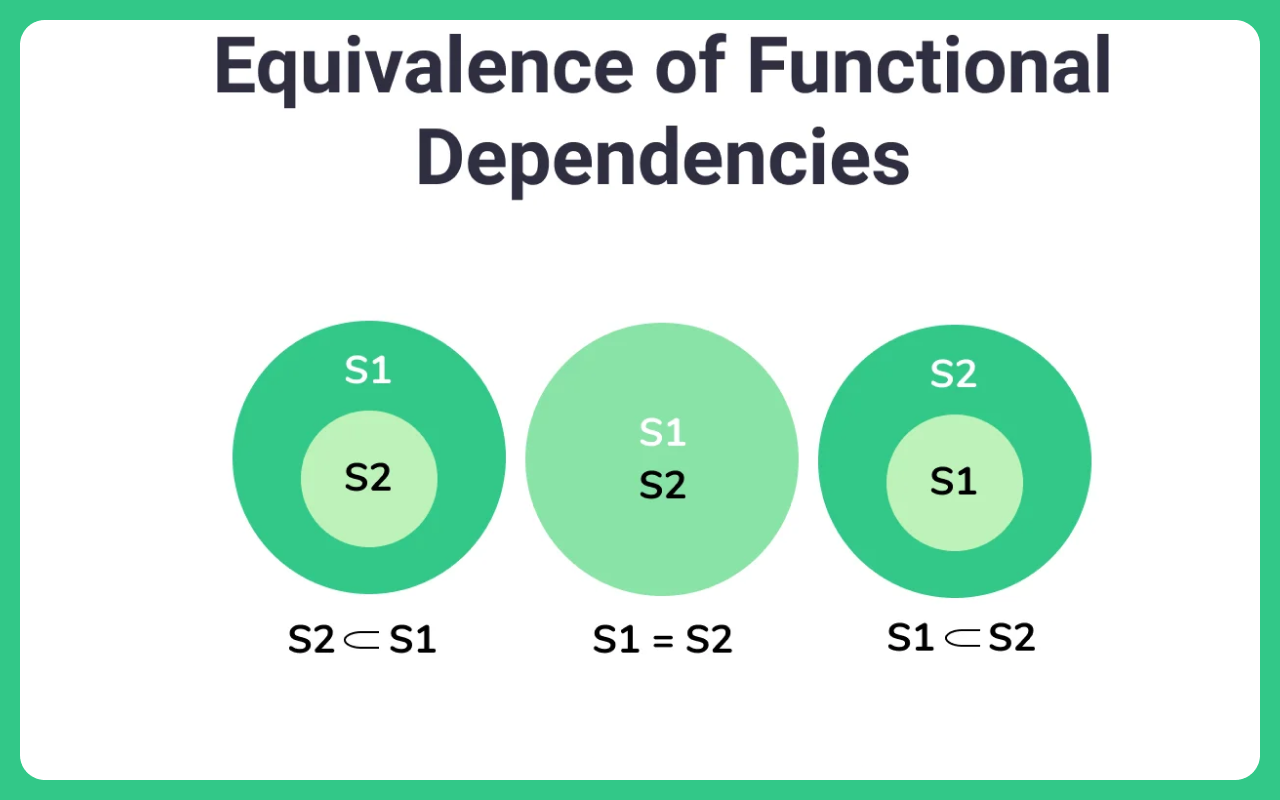Equivalence of functional dependencies in DBMS
Equivalence of functional dependencies in DBMS
In this article, we will learn about the Equivalence of functional dependencies in DBMS. Equivalence of functional dependencies is nothing but we need to determine whether all functional dependencies existed for the relation are equal or not.

Equivalence of functional dependenciesis nothing but we need to determine whether all functional dependencies existed for the relation are equal or not- You will be given a relation with different functional dependency sets of that relationship you need to check whether one functional dependency is a subset of other or both are equal.
Learn more about Functional Dependencies here on this page.

Finding a relationship between two to FD (functional dependency) sets
Consider S1 and S2 are two FD sets for a relation R.
- If all FDs of S1 can be determined from FDs that are present in S2, we can conclude that S2 ⊃ S1.
- If all FDs of S2 can be determined from FDs that are present in S1, we can conclude FD1 ⊃ FD2.
- If 1 and 2 are satisfied then, S1=S2.
Check for the equivalence of functional dependencies for A relation R (A, B, C, D) having two FD sets S1 = {A->B, B->C, AB->D} and S2= {A->B, B->C, A->C, A->D}
Solution:
- Step 1. Checking whether all FDs of set S1 is present in set S2
- FD A->B in set S1 is present in set S2.
- FD B->C in set S1 is also present in set S2.
- FD AB->D in present in set S1 but not in S2 but we have to check whether we can derive it or not. In set S2, (AB) + = {A, B, C, D}. It means that A,B,C,D can be determined functionally from AB which implies AB->D holds true for set S2
- As all FDs in set S1 also hold in set S2, S2 ⊃ S1 is true.
- Step 2. Checking whether all FDs of S2 are present in S1
- FD A->B in set S2 is present in set S1.
- FD B->C in set S2 is also present in set S1.
- FD A->C is present in S2 but not in S1 but we have to check whether we can derive it or not. In set S1, (A) + = {A, B, C, D}. It means that A,B,C,D can be determined functionally from A which implies A->C holds true for set S1.
- FD A->D is present in S2 but not in S1 but we have to check whether we can derive it or not. In set S1, (A) + = {A, B, C, D}. It means that A,B,C,D can be determined functionally from A which implies A->D holds true for set S1.
- As all FDs in set S2 also hold in set S1, S1 ⊃ S2 is true.
- Step 3. We can conclude that S1=S2 as both S2⊃ S1 and S1⊃ S2 are true. Hence these two FD sets are semantically equivalent.
Prime Course Trailer
Related Banners
Get PrepInsta Prime & get Access to all 200+ courses offered by PrepInsta in One Subscription
Get over 200+ course One Subscription
Courses like AI/ML, Cloud Computing, Ethical Hacking, C, C++, Java, Python, DSA (All Languages), Competitive Coding (All Languages), TCS, Infosys, Wipro, Amazon, DBMS, SQL and others






Login/Signup to comment